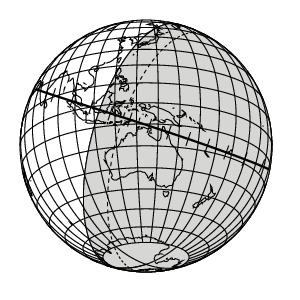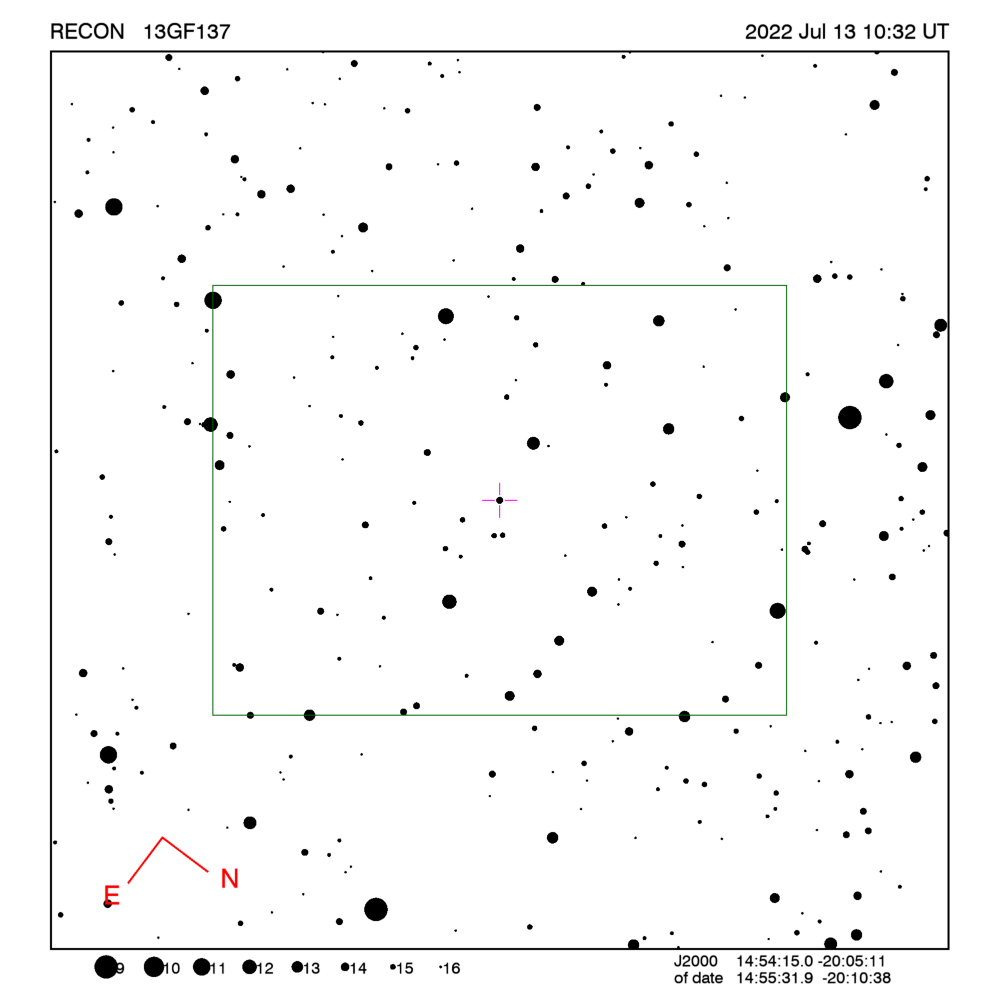RECON: TNO occultation with 13GF137
Event between 13GF137 and star GA0680:06036363
with event index number of 2052475
Geocentric closest approach at 2022/07/13 10:31:36 UTC
J2000 position of star is 14:54:15.0 -20:05:11
Equinox of date position of star is 14:55:30.8 -20:10:33
Stellar brightness G=14.9,
use SENSEUP=128 with the MallinCam and and exposure
time of 2 seconds with the QHY174 camera.
Star is 59 degrees from the moon.
Moon is 100% illuminated.
TNO apparent brightness V=24.0
 TNO is 38.7 AU from the Sun
and 38.2 AU from the Earth.
TNO is 38.7 AU from the Sun
and 38.2 AU from the Earth.
The TNO is moving 8.3
km/sec on the sky relative to the star, or,
1.1 arcsec/hr.
The 1-sigma error in the time of the event is 898 seconds.
The 1-sigma cross-track error in the shadow position is
5434 km.
The TNO has an absolute magnitude Hv=8.0
Diameter=148.6 km assuming a 5% albedo -- 17.9 sec chord
Diameter=60.7 km assuming a 30% albedo -- 7.3 sec chord
Dynamical classification is 3:2E
Star training set for 13GF137, (2022/07/13 10:32UT)
Object RA Dec mag sep mel
Antares 16:30:47.6 -26:28:48 0.9 22.72 36
27Bet Lib 15:18:13.4 -09:27:53 2.6 12.03 58
PPM 229408 14:53:07.4 -18:26:49 6.2 1.82 60
PPM 229451 14:54:57.0 -20:03:49 7.9 0.18 59
13GF137 14:55:31.9 -20:10:38 14.9 59
Positions are for equinox of date

Azimuth is measured in degrees eastward from north.
North is at an azimuth of 0, due East is at an azimuth
of 90 degrees, due South is 180, and due West is 270.
Do not use the listing below for the RECON CPC 1100 telescopes.
This is provided for other non-team facilities.
Star training set for 13GF137, (2022/07/13 10:32UT)
Object RA Dec mag sep mel
Antares 16:29:24.4 -26:25:56 0.9 22.72 36
27Bet Lib 15:17:00.3 -09:22:59 2.6 12.03 58
PPM 229408 14:51:51.3 -18:21:19 6.2 1.82 60
PPM 229451 14:53:40.2 -19:58:22 7.9 0.18 59
13GF137 14:54:15.0 -20:05:11 14.9 59
Positions are for J2000
Event circumstances last updated at 2022/03/14 01:05:39 UT
Marc W. Buie,
Southwest Research Institute
RECON
 TNO is 38.7 AU from the Sun
and 38.2 AU from the Earth.
TNO is 38.7 AU from the Sun
and 38.2 AU from the Earth.
